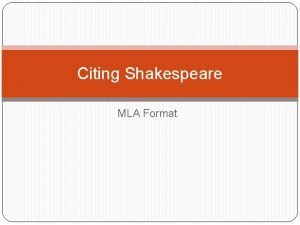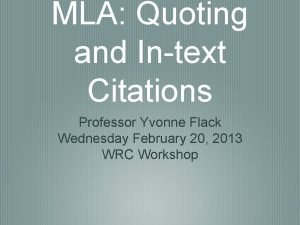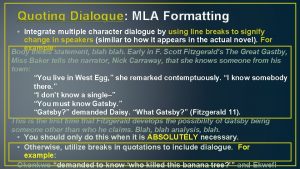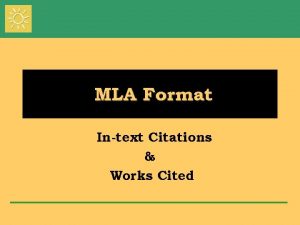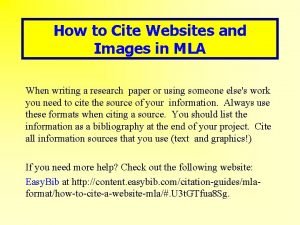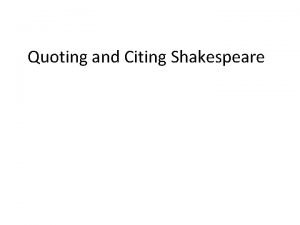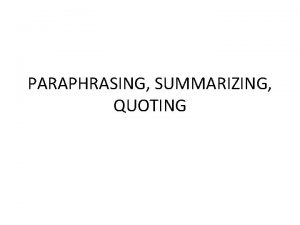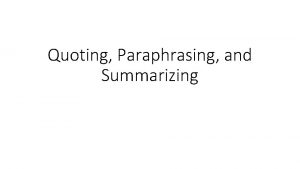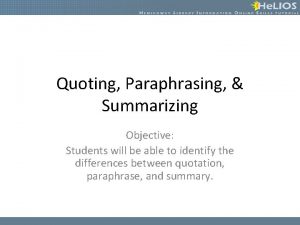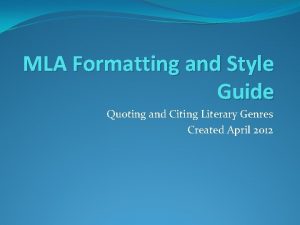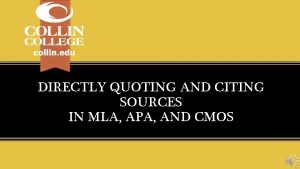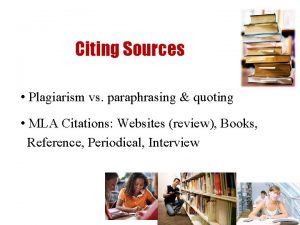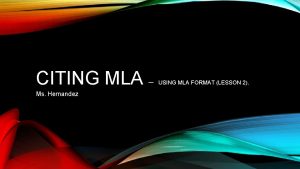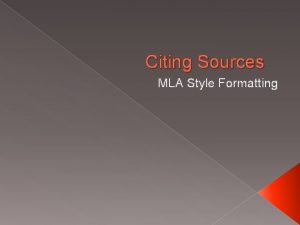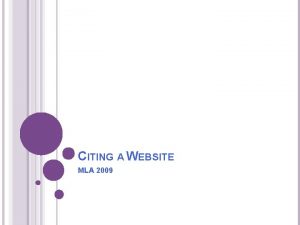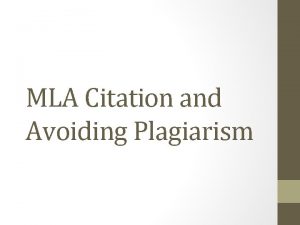Quoting and Citing Shakespeare MLA Guidelines For all













- Slides: 13

Quoting and Citing Shakespeare

MLA Guidelines • For all questions about how to use citations, go to the EDSS Library site. • Click on Referencing (APA, MLA, Chicago) • The MLA Style Guide is most often used for the Liberal Arts and the Humanities. It is the guide followed by the EDSS English Department

Play Titles • Italicize play titles: Romeo and Juliet, Twelfth Night, or Macbeth

Quoting Verse • When you quote from a play, divide lines of verse with slashes the way you would if quoting poetry. You can tell a passage is in verse by examining it to see if every line starts with a capital letter, regardless of whether the line starts a sentence. Example: At the end of the play, the Prince says: “For never was a story of more woe/ Than this of Juliet and her Romeo” (5. 3. 309 -310).

Quoting Prose • When you quote prose from a play, no slashes are necessary. You can recognize prose by the fact that, in prose, every sentence begins with a capital letter, but not every line on the page. Example: In Act 1, Scene 2, the servant worries that “I am sent to find those persons whose names are here writ, and can never find what names the writing person hath here writ. I must to the learned” (4144).

References • Please note that your references at the end of your quotations should refer to Act, scene and line numbers (as in the examples above) , not to page numbers. You may either use Roman numerals or Arabic ones as you prefer. Example: • (1. 1. 12 -23) or (I. i. 12 -23) -- In this reference, the quotation would come from Act I, scene i, lines 12 -23. • The period should always appear at the end of your sentence; that is, after the parenthetical reference, unless it is a quotation longer than 3 lines of verse or 4 lines of prose (see next slide).

• If you are quoting more than three lines of verse or four lines of prose, you will need to indent your quotation. The lines should be arranged as they appear in the text if you are quoting verse and arranged as a paragraph if you are quoting prose. • In this case, the punctuation comes at the end of the quotation. Example: When Romeo learns that he is banished from Verona he mourns: There is no world without Verona walls, But purgatory, torture, hell itself. Hence banished is banish’d from the world, And world’s exile is death; then banished is death mis-term’d. (3. 3. 17 -21)

No Hanging Quotations • Include your quotations from the plays within your own sentences, and end your paragraphs with your own thoughts rather than a quotation.

• Use a colon when introducing a quotation with a full sentence. Example: Romeo proves that he falls in and out of love easily throughout the play: “With Rosaline, my ghostly father? no; / I have forgot that name, and that name’s woe” (2. 3. 45 -46).

• Use a comma when integrating a quotation into a sentence (usually when introducing speech). Example: Friar Lawrence displays his wisdom when he says, “[y]oung men’s love then lies / Not truly in their hearts, but in their eyes” (2. 3. 67 -68).

• You may also integrate a quotation into a sentence without a comma. Example: Romeo’s character demonstrates that “[y]oung men’s love then lies / Not truly in their hearts, but in their eyes” (2. 3. 67 -68), when he falls in love with Juliet at first sight.

• Offset the text, do not use quotation marks and place the period BEFORE the brackets when citing four lines or more. Example: Juliet shows that she questions Romeo’s intentions, but also her commitment to him, during the balcony scene: If that thy bent of love be honourable, Thy purpose marriage, send me word tomorrow, By one that I’ll procure to come to thee, Where and what time thou wilt perform the rite, And all my fortunes at thy foot I’ll lay, And follow thee my lord throughout the world. (2. 2. 142 -148)

In general… • Punctuation goes AFTER brackets of citation except when there is a question or exclamation mark, or when citing four lines or more • Use square brackets if you change a word or capitalization
 How to cite shakespeare
How to cite shakespeare Mla citing shakespeare
Mla citing shakespeare Quoting poetry in mla
Quoting poetry in mla Quoting dialogue mla
Quoting dialogue mla How to in text citation website no author
How to in text citation website no author What is mla format for citing sources
What is mla format for citing sources Mla format citing textual evidence
Mla format citing textual evidence Mla picture citation
Mla picture citation How to quote plays
How to quote plays Try to practice paraphrasing summarizing and direct quoting
Try to practice paraphrasing summarizing and direct quoting Pepsi coca cola halloween ad
Pepsi coca cola halloween ad Quoting summarizing and paraphrasing
Quoting summarizing and paraphrasing Direct material sourcing ariba
Direct material sourcing ariba Quoting, paraphrasing and summarizing examples
Quoting, paraphrasing and summarizing examples

